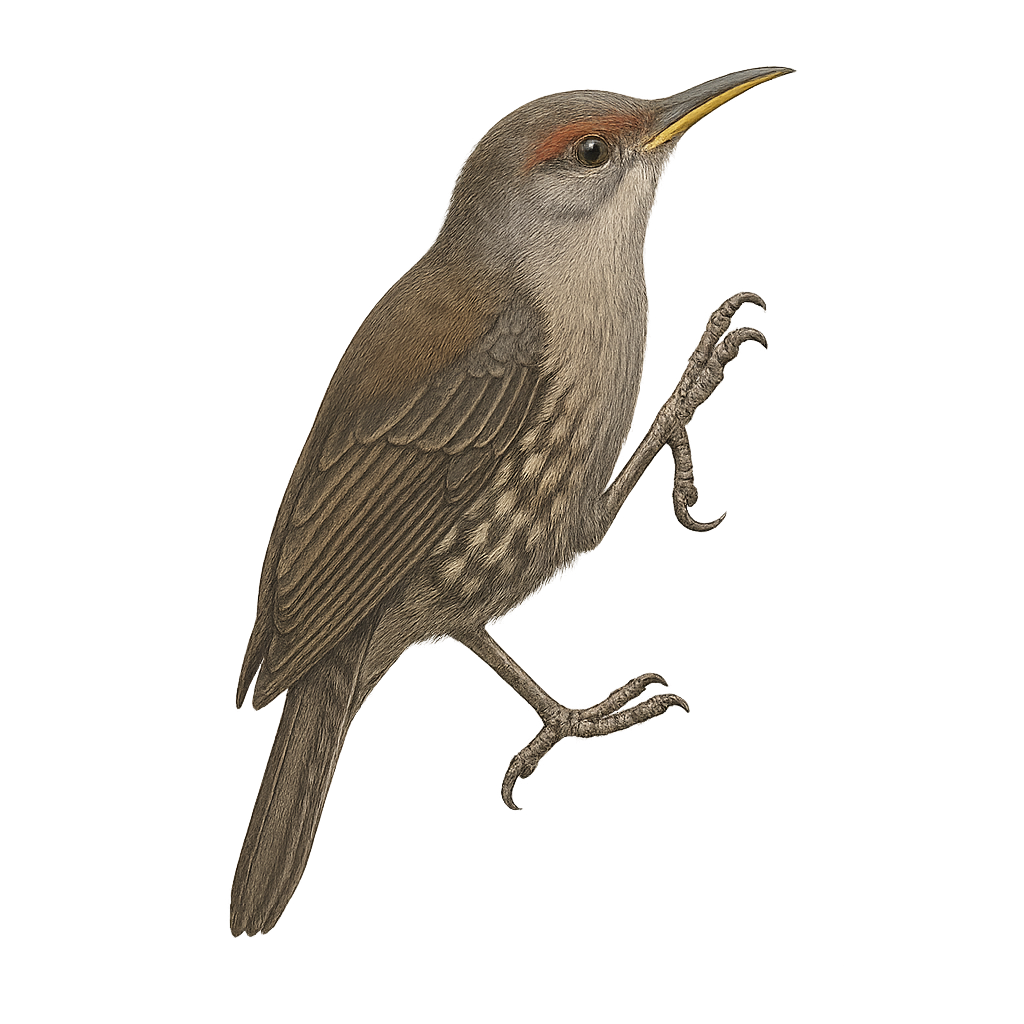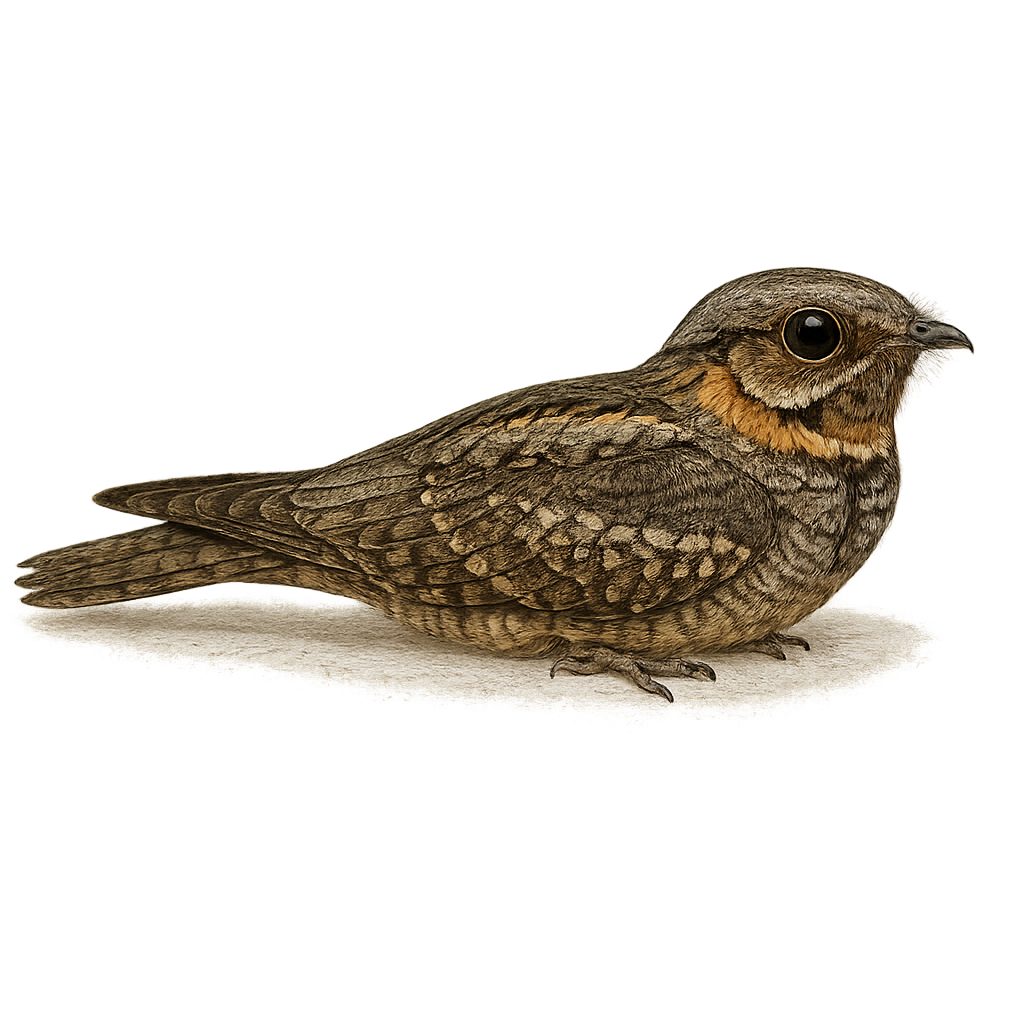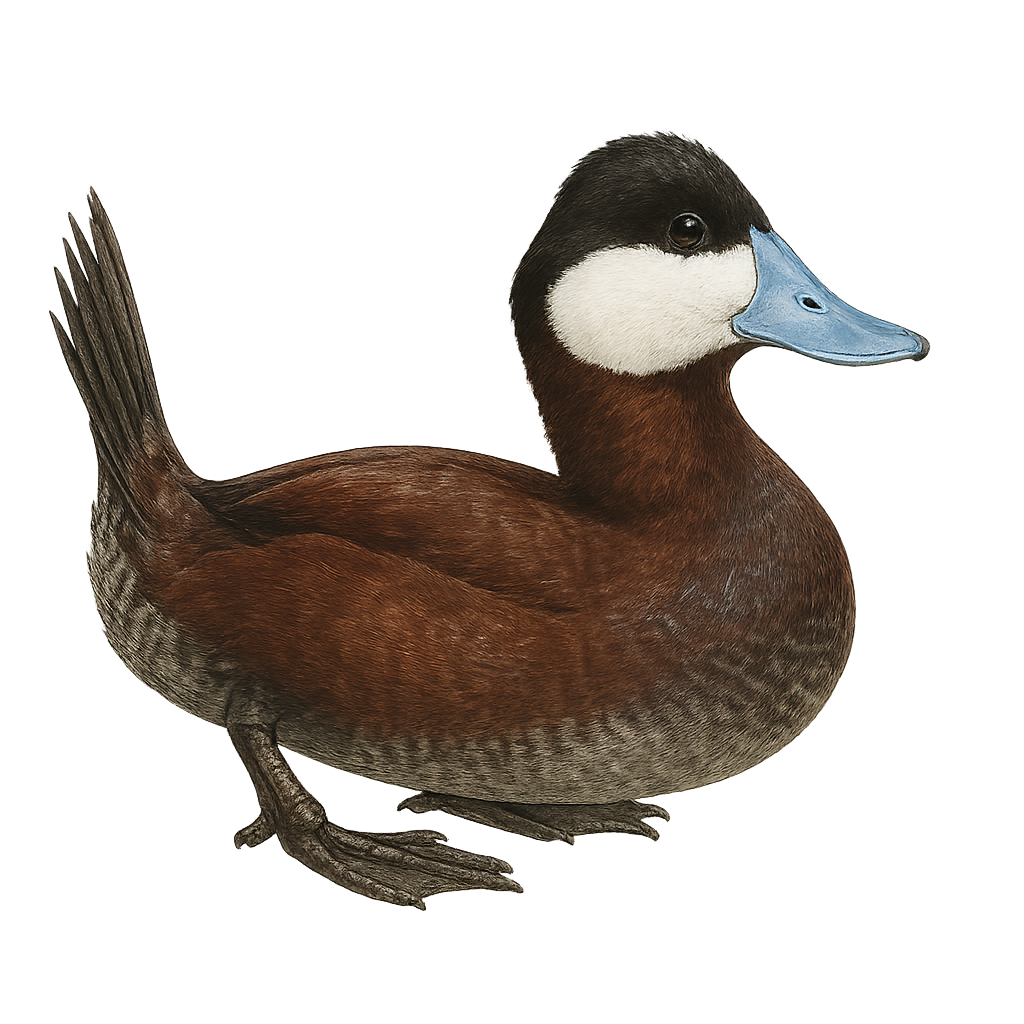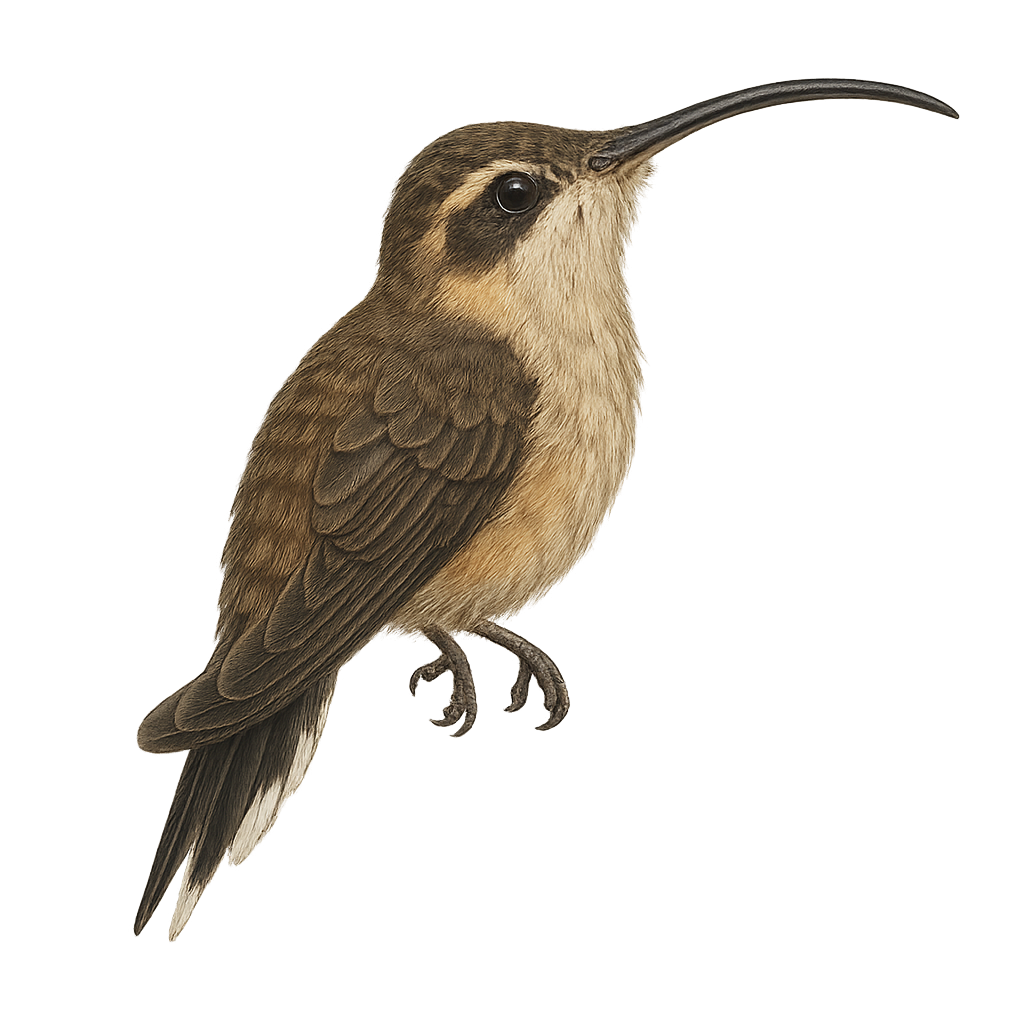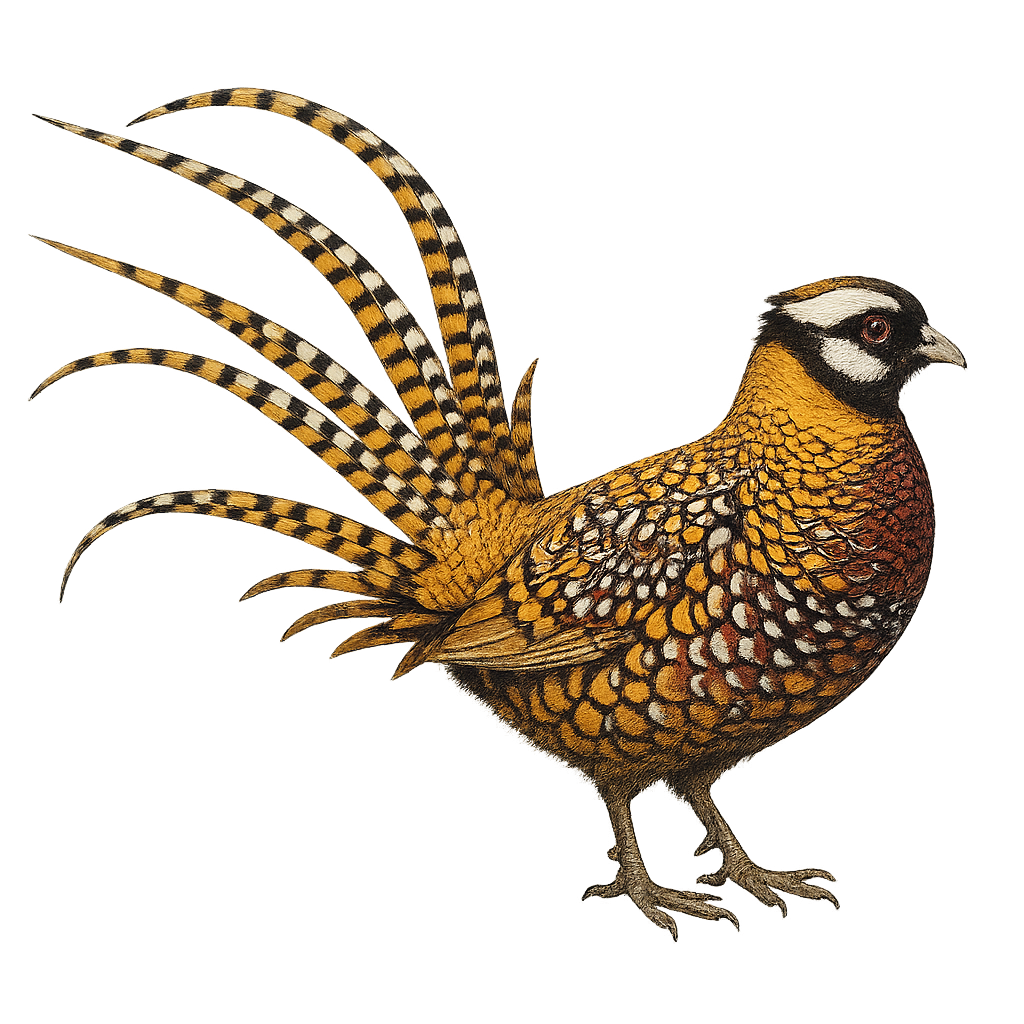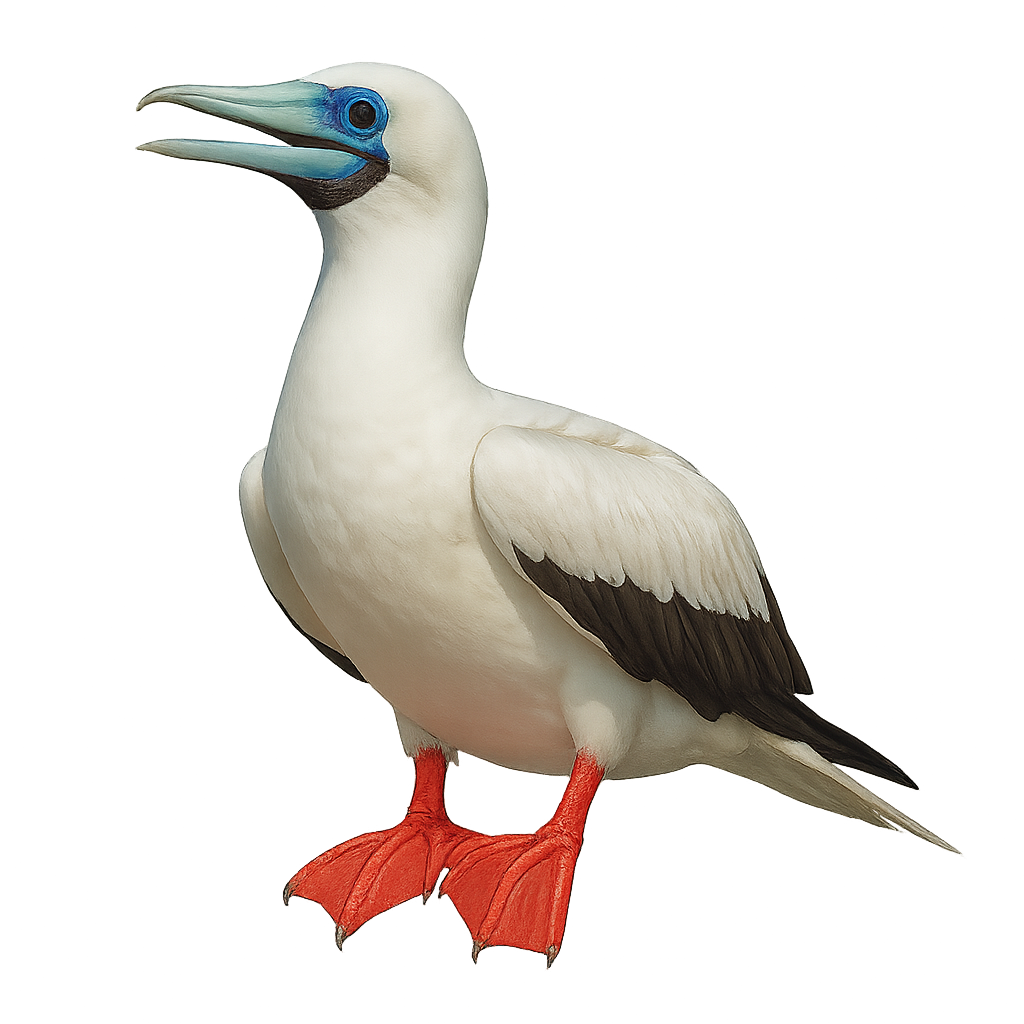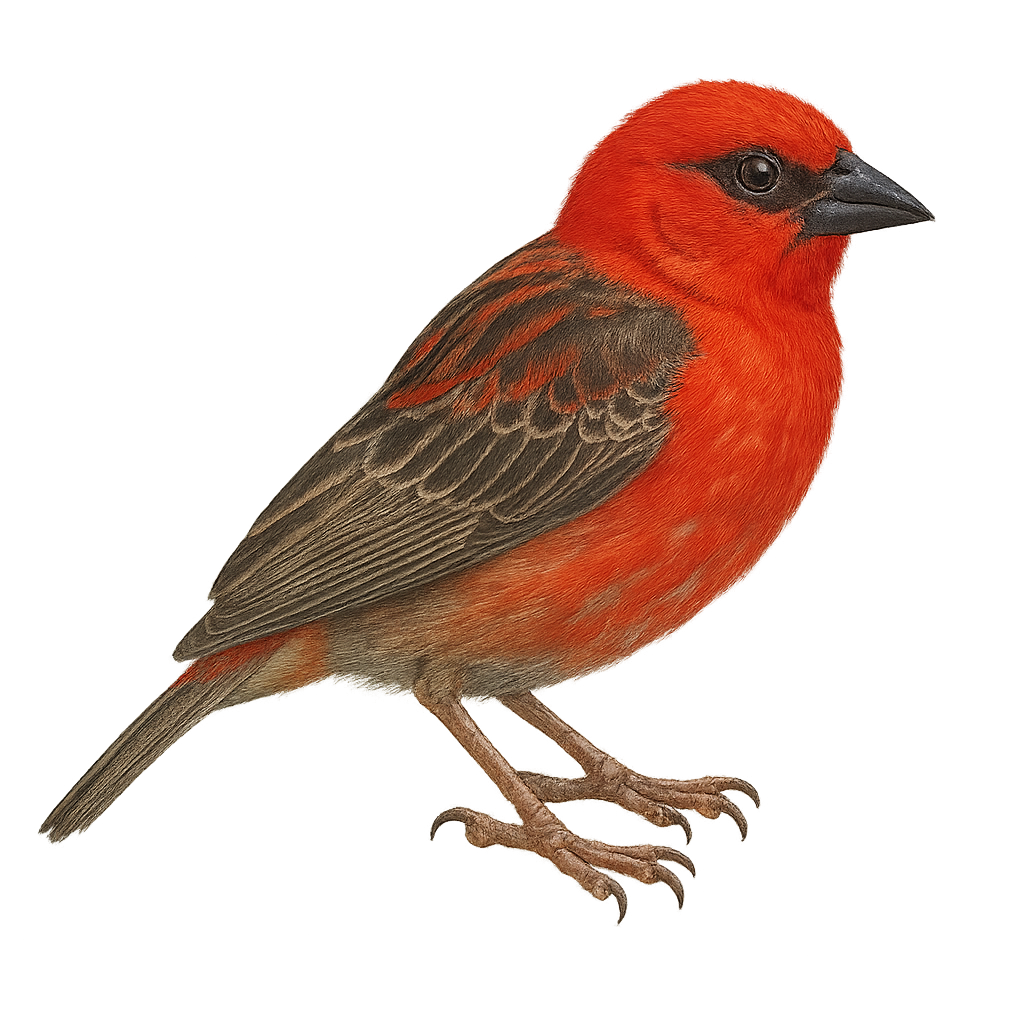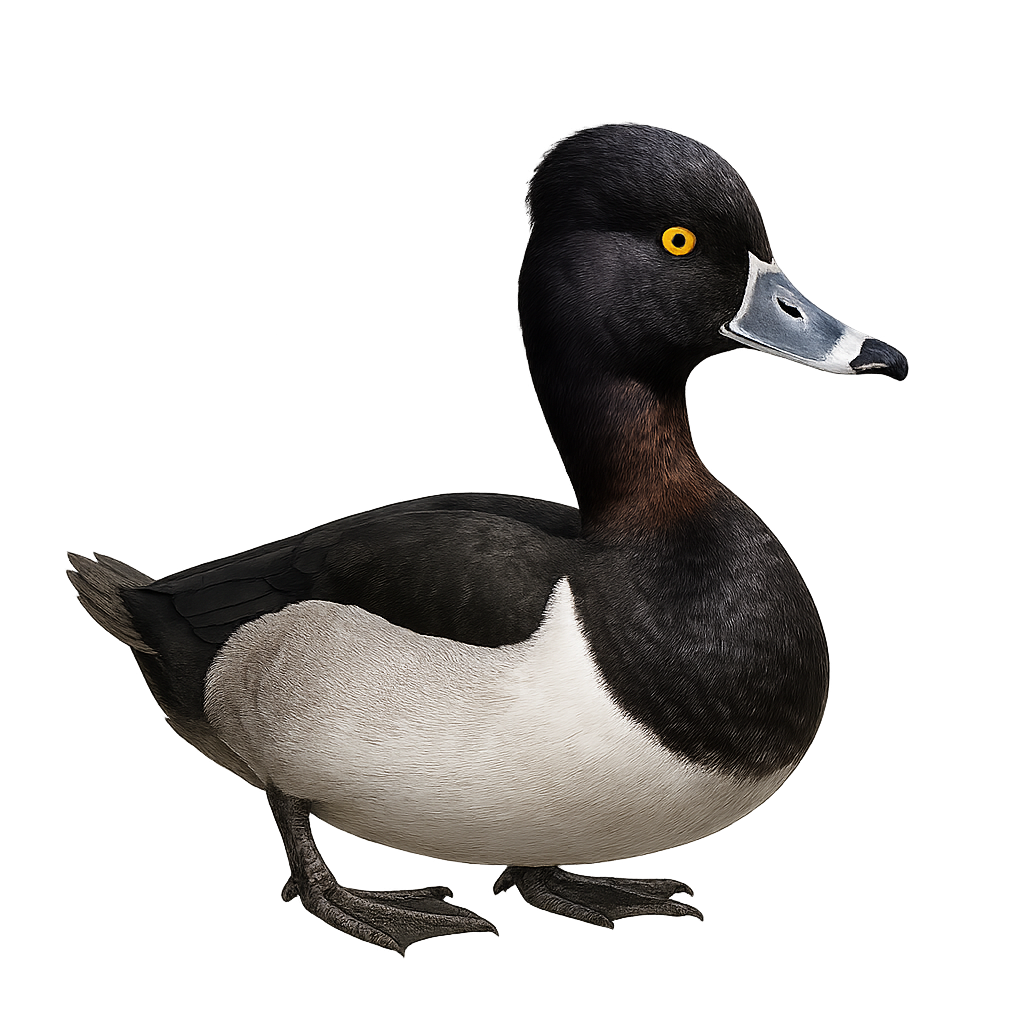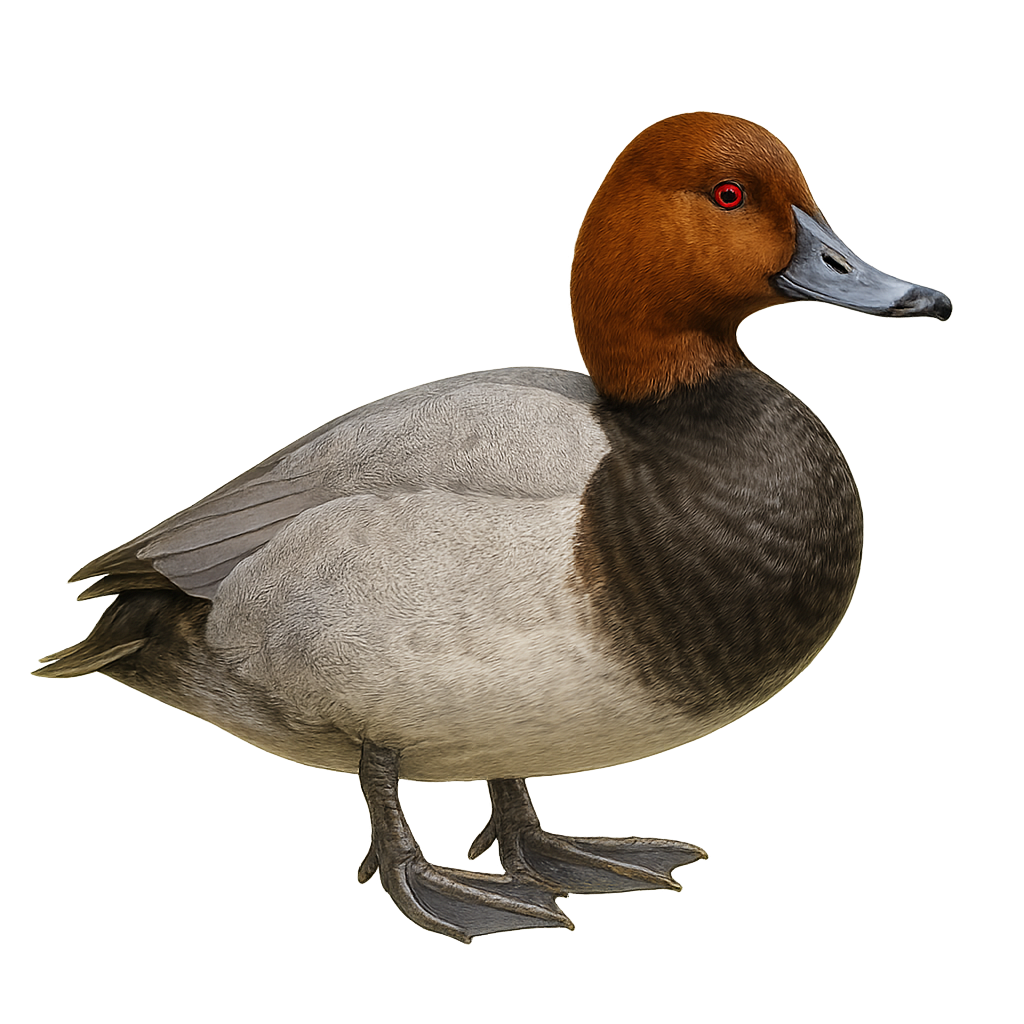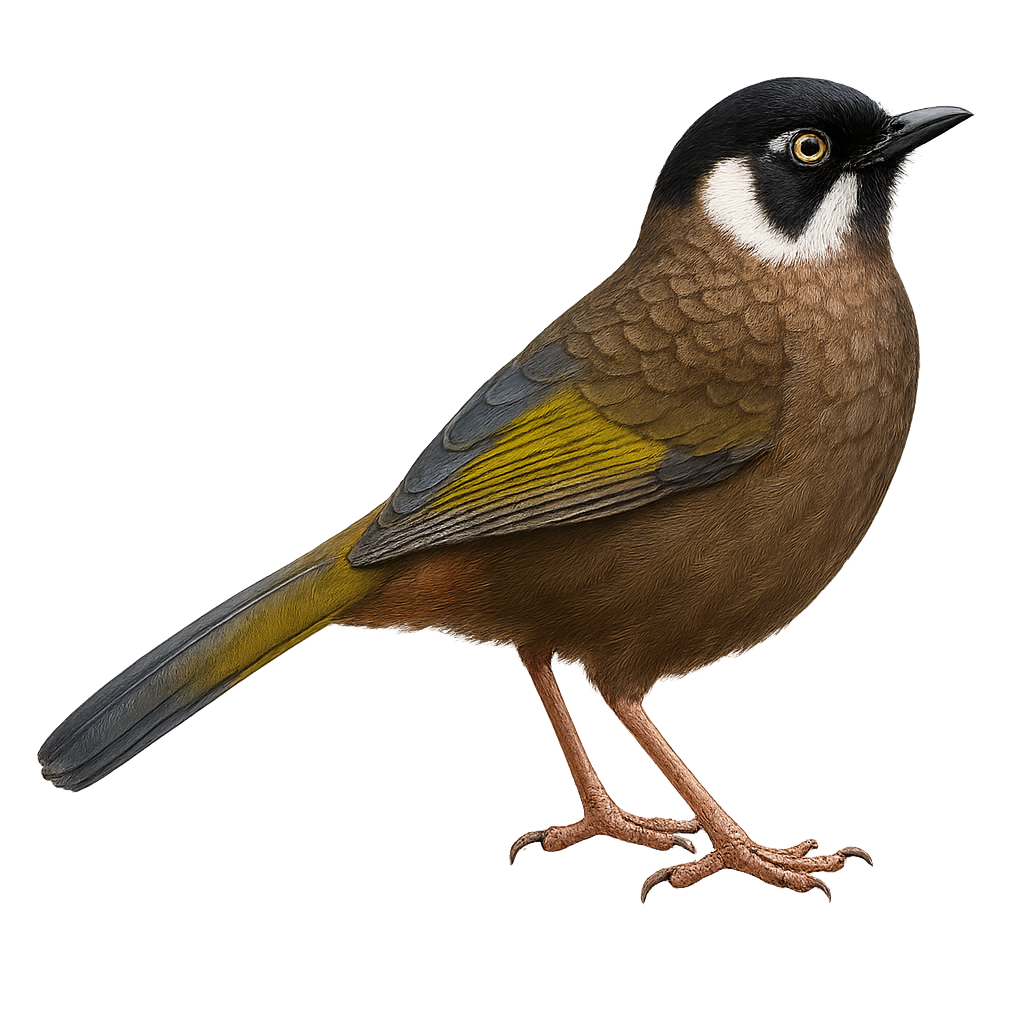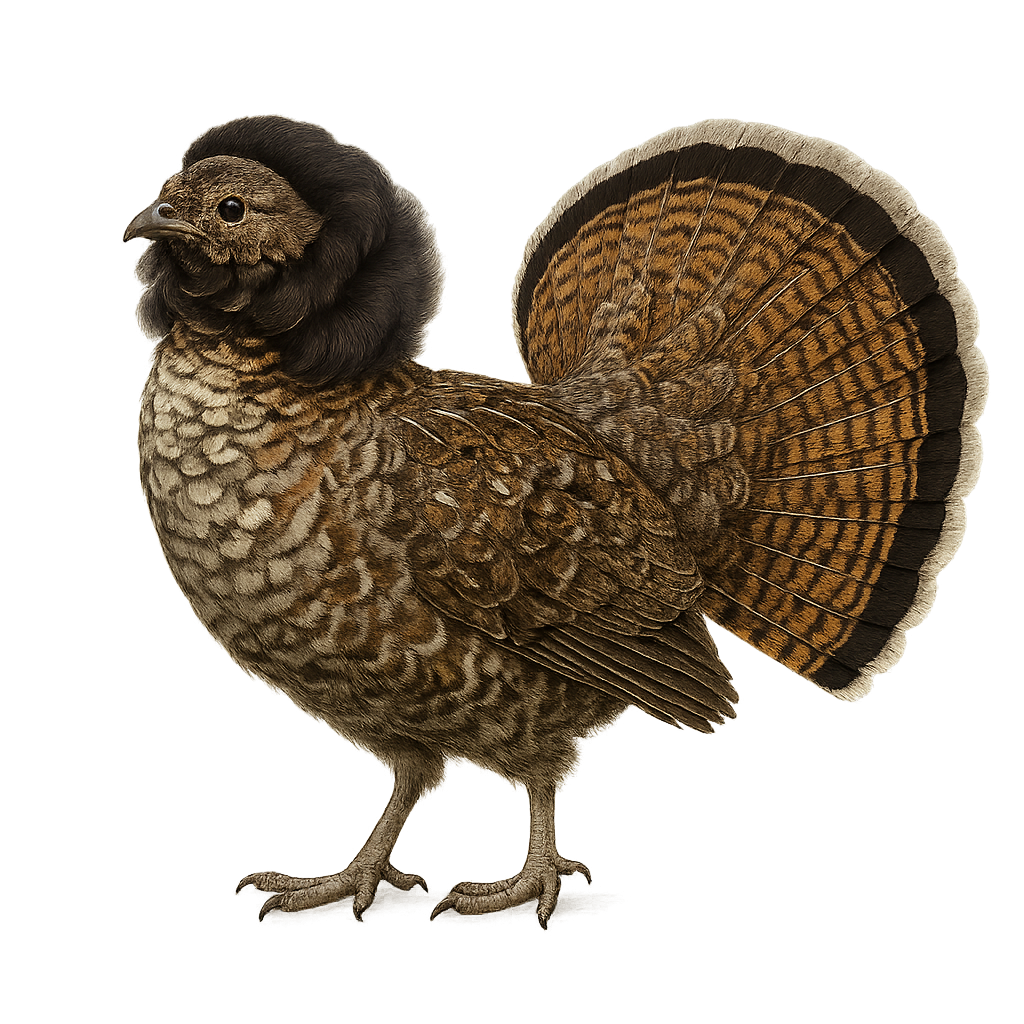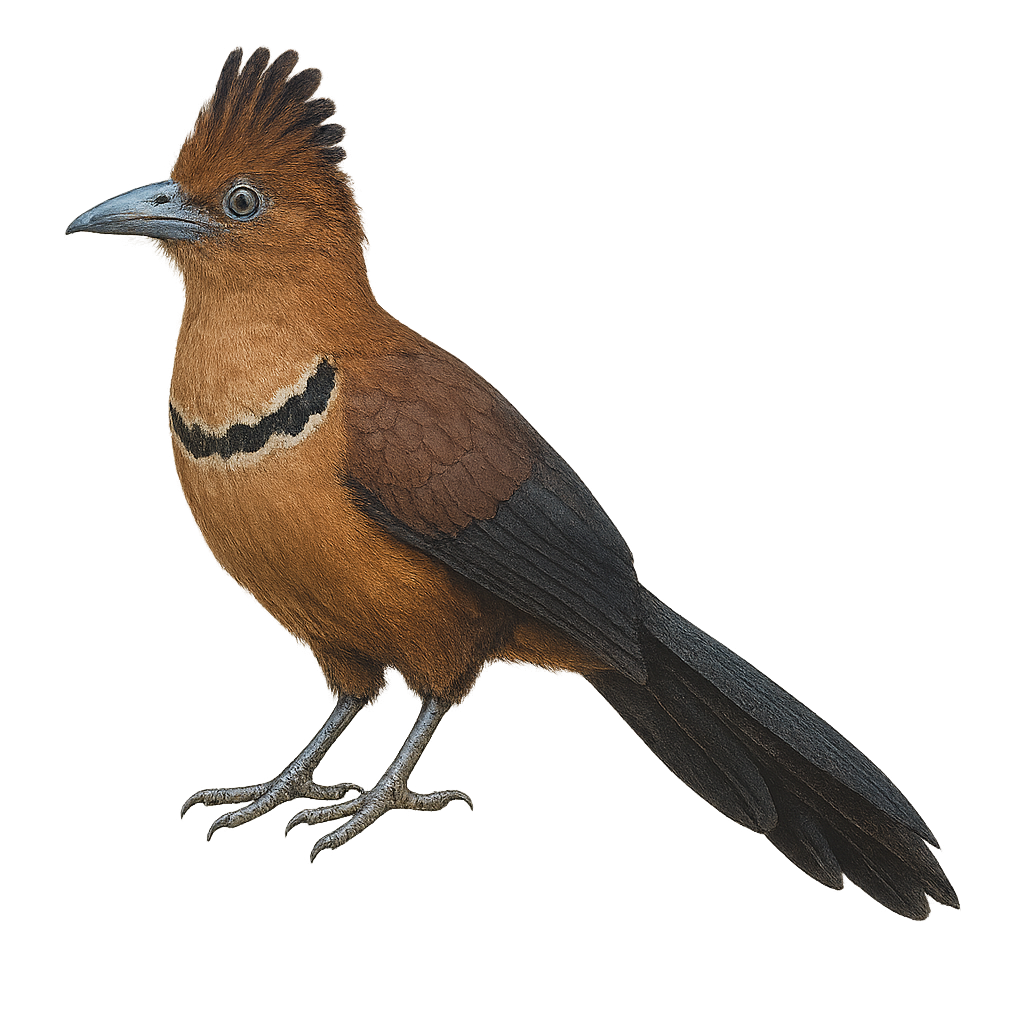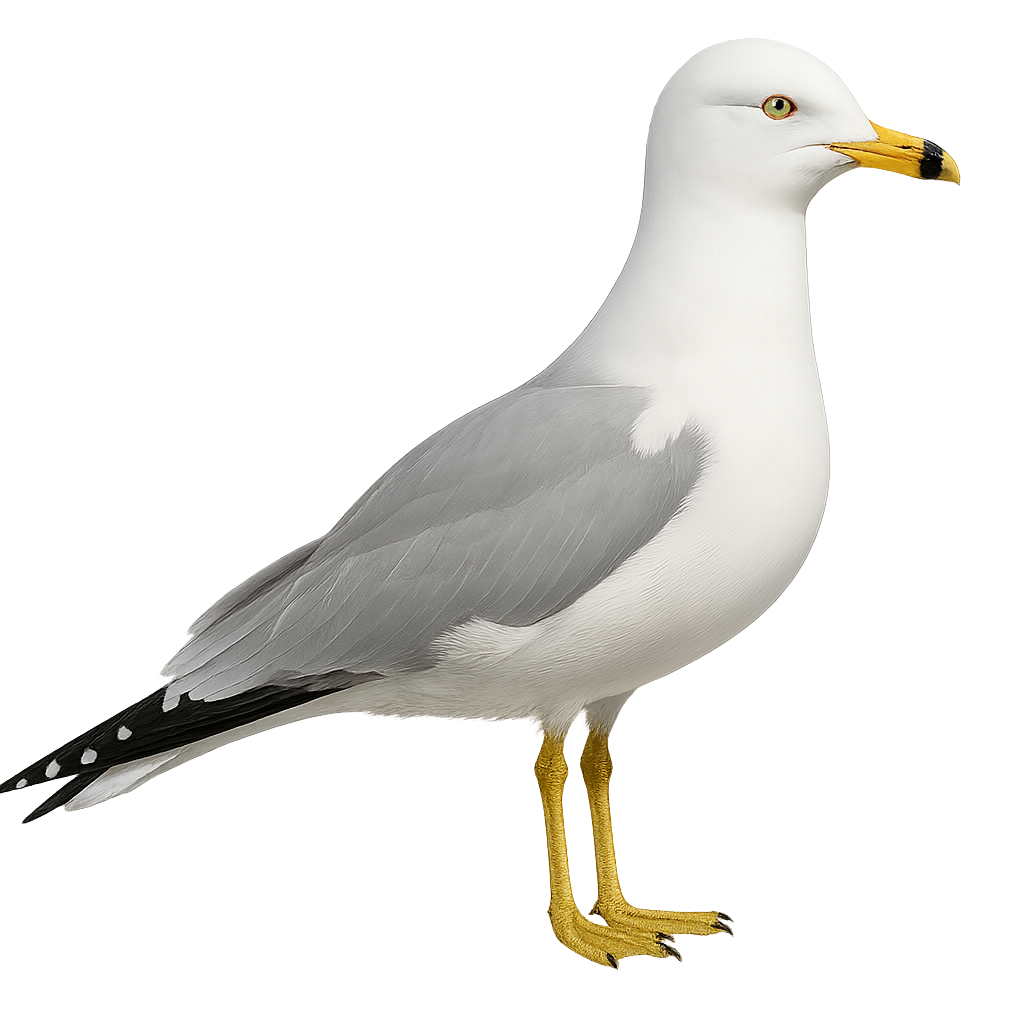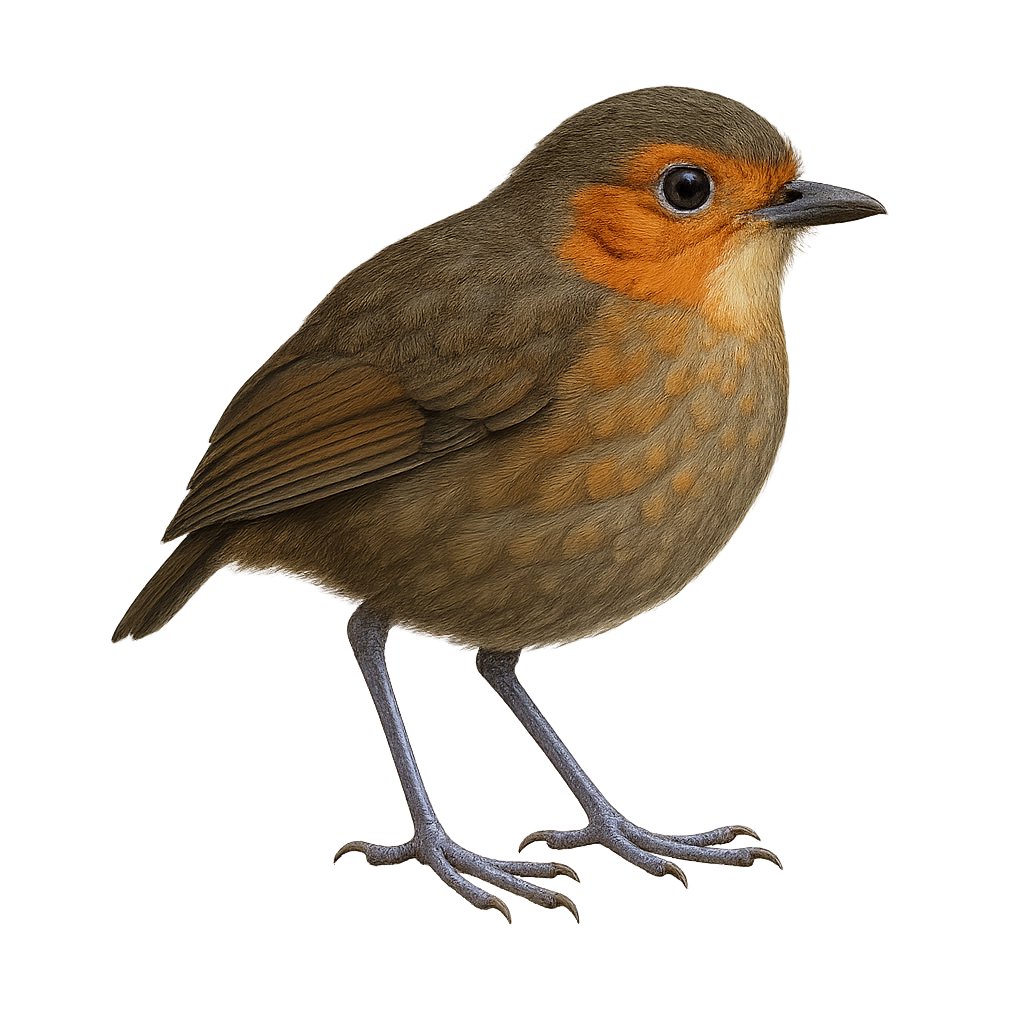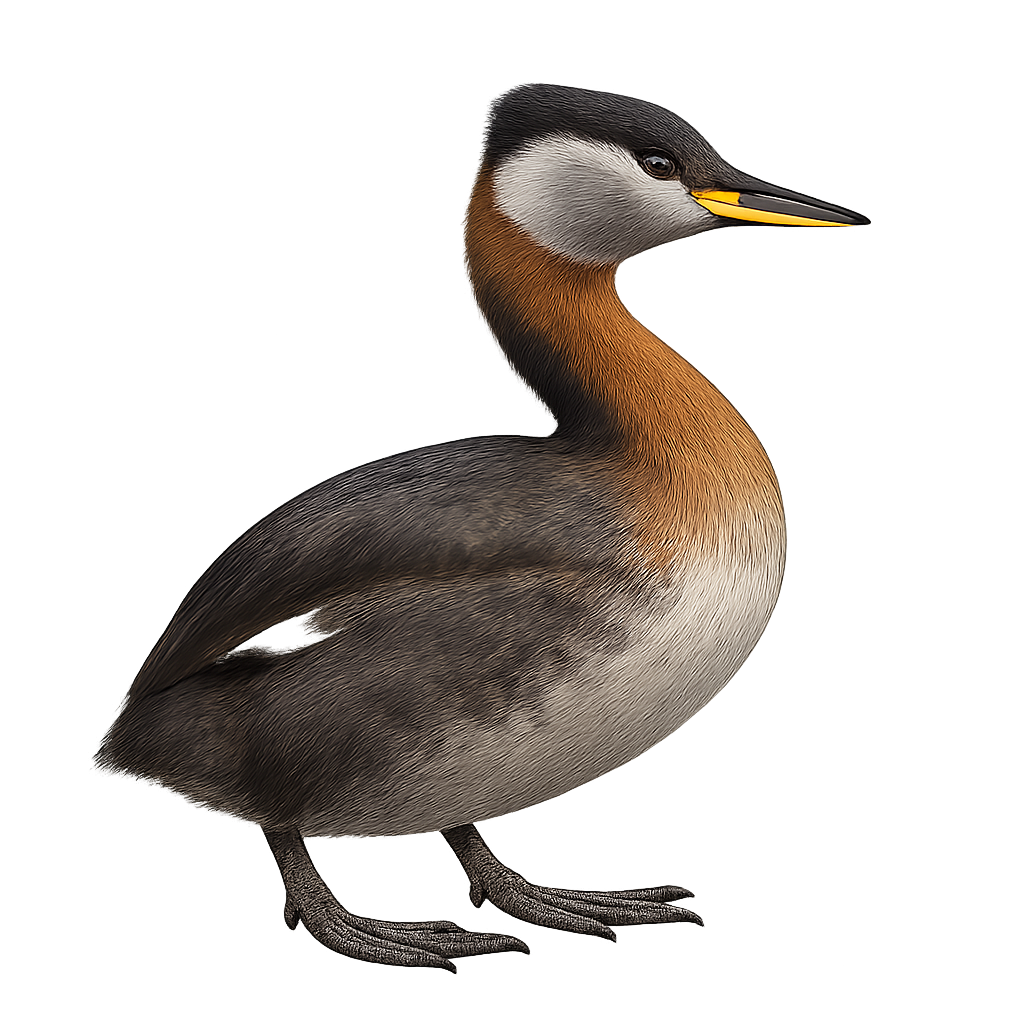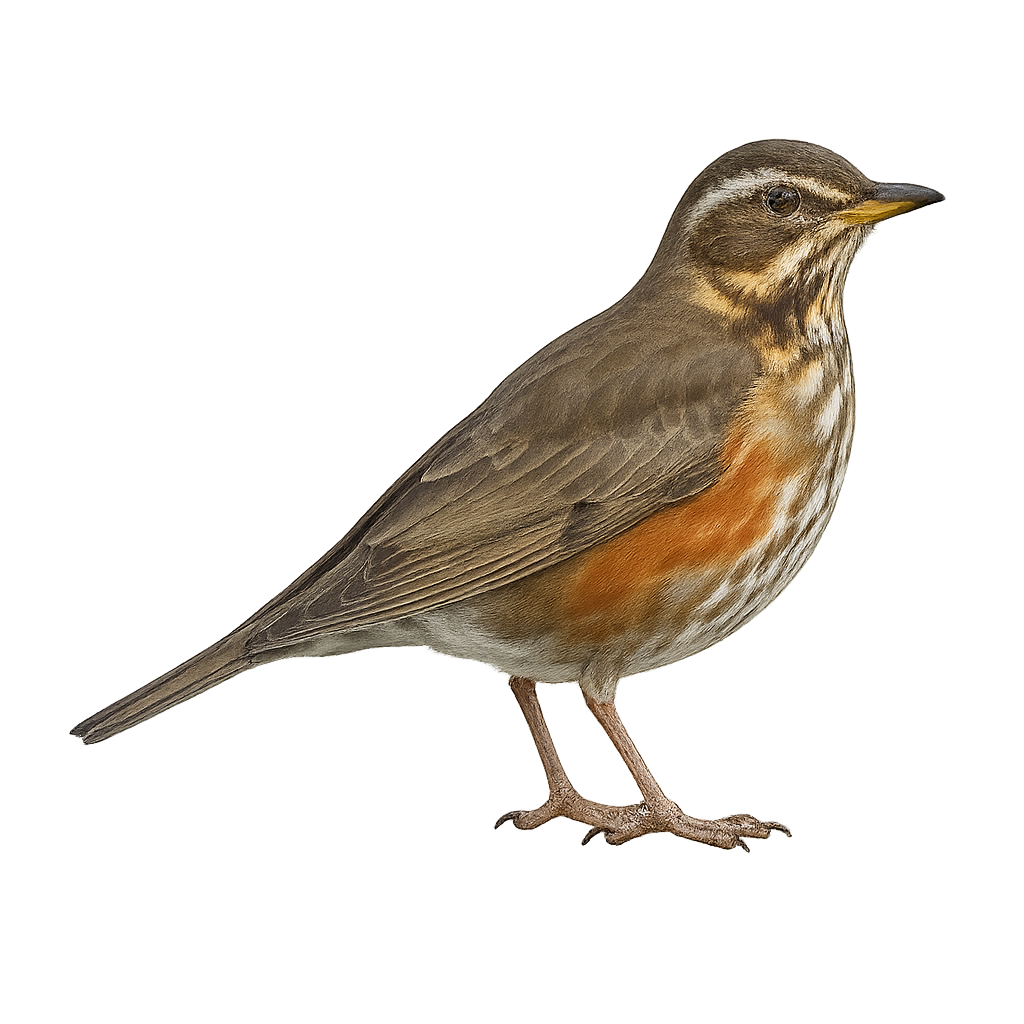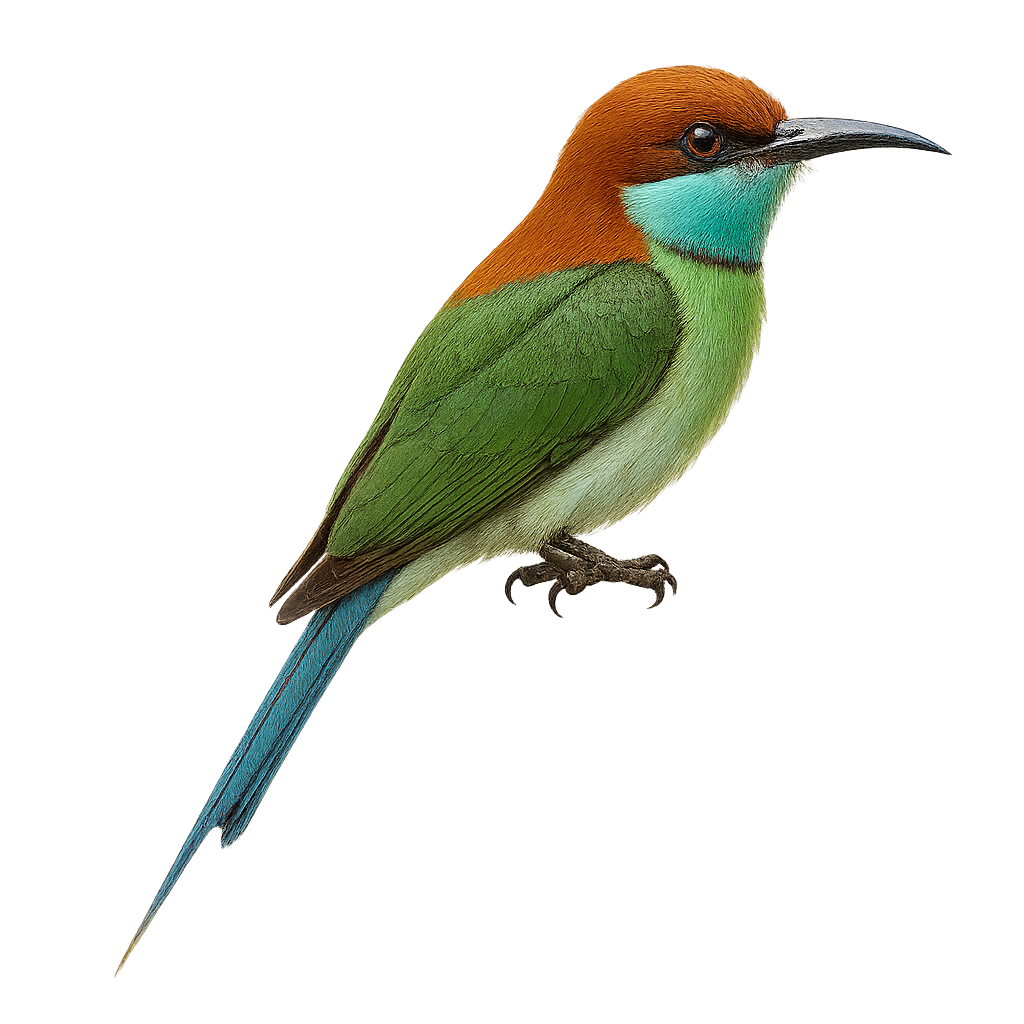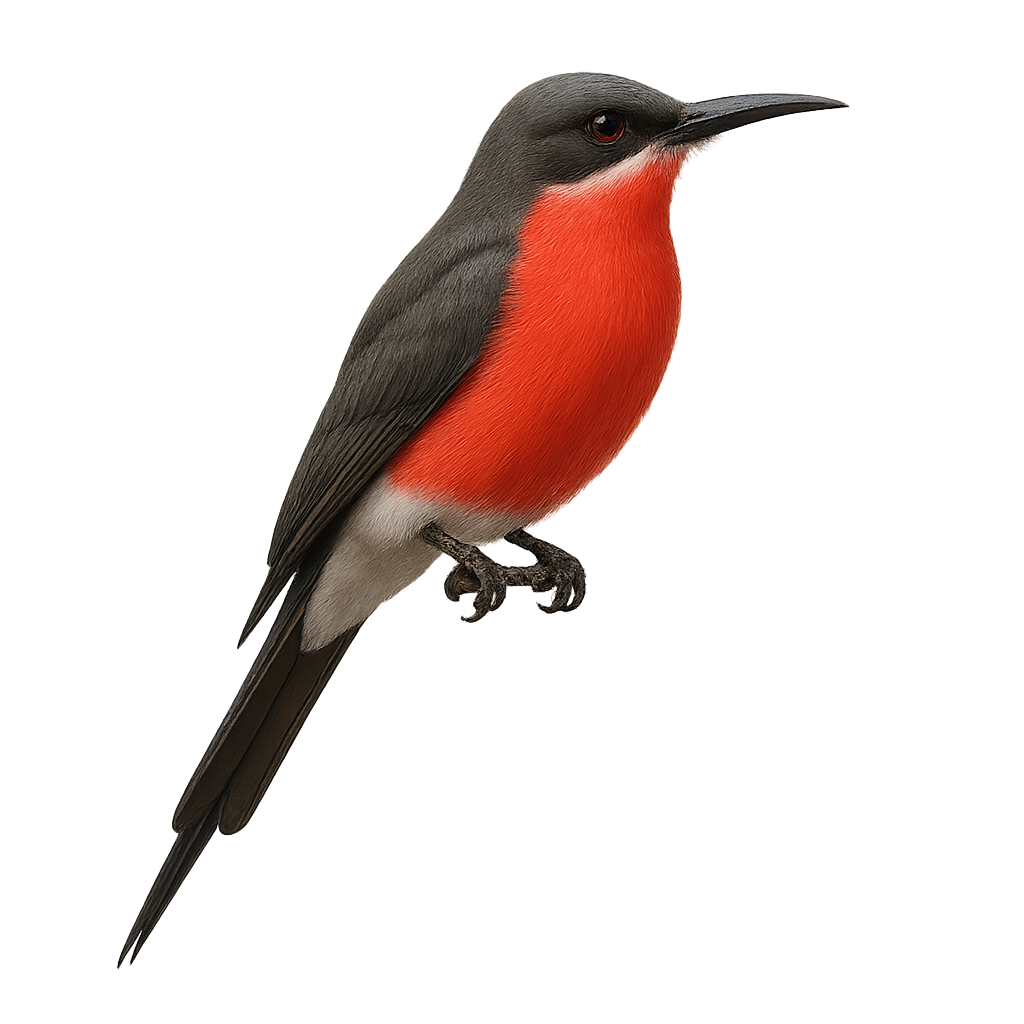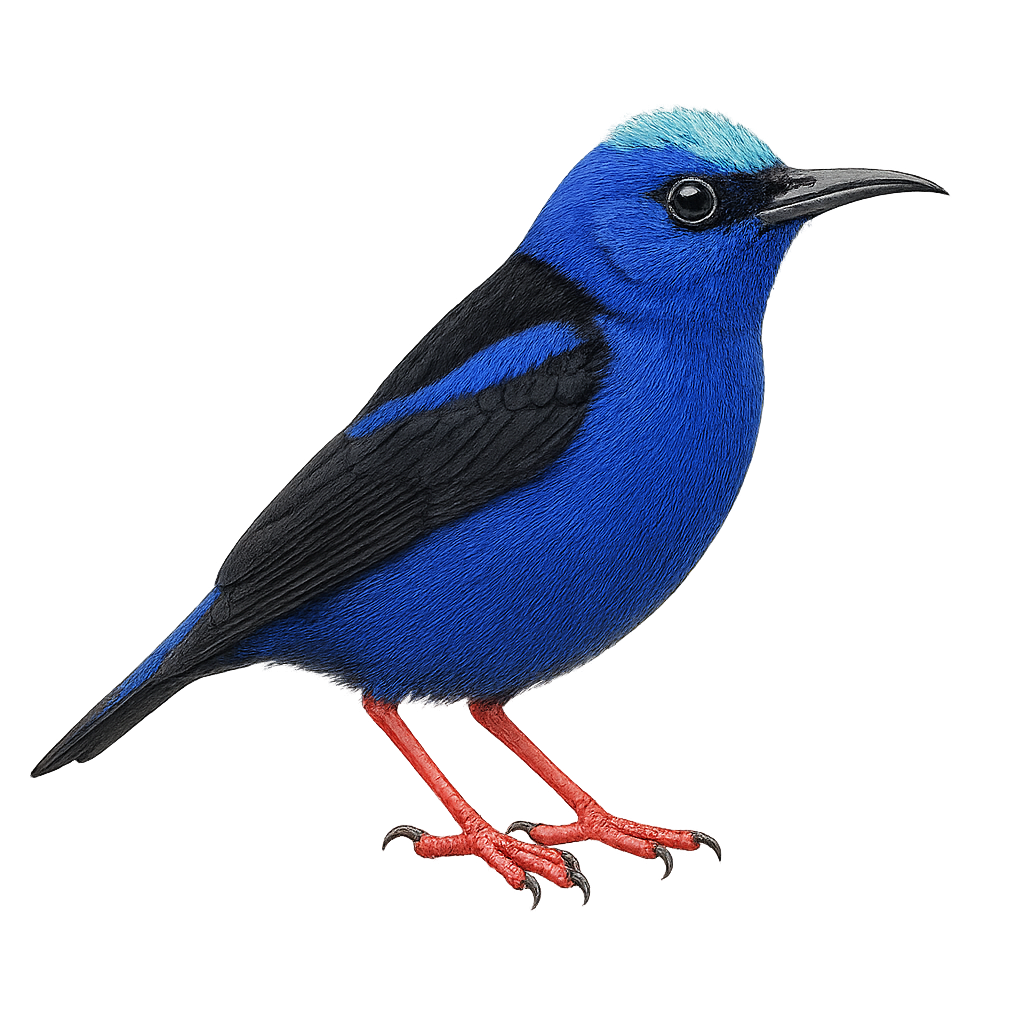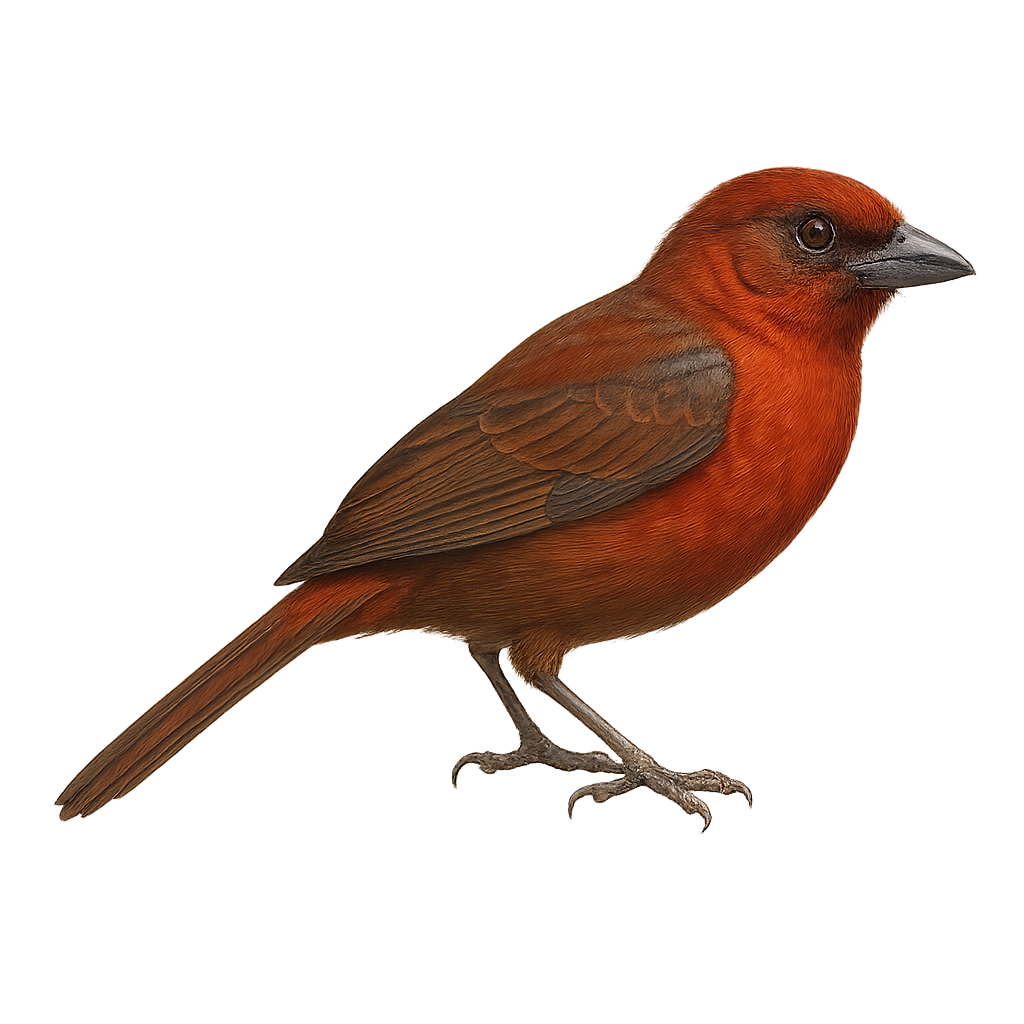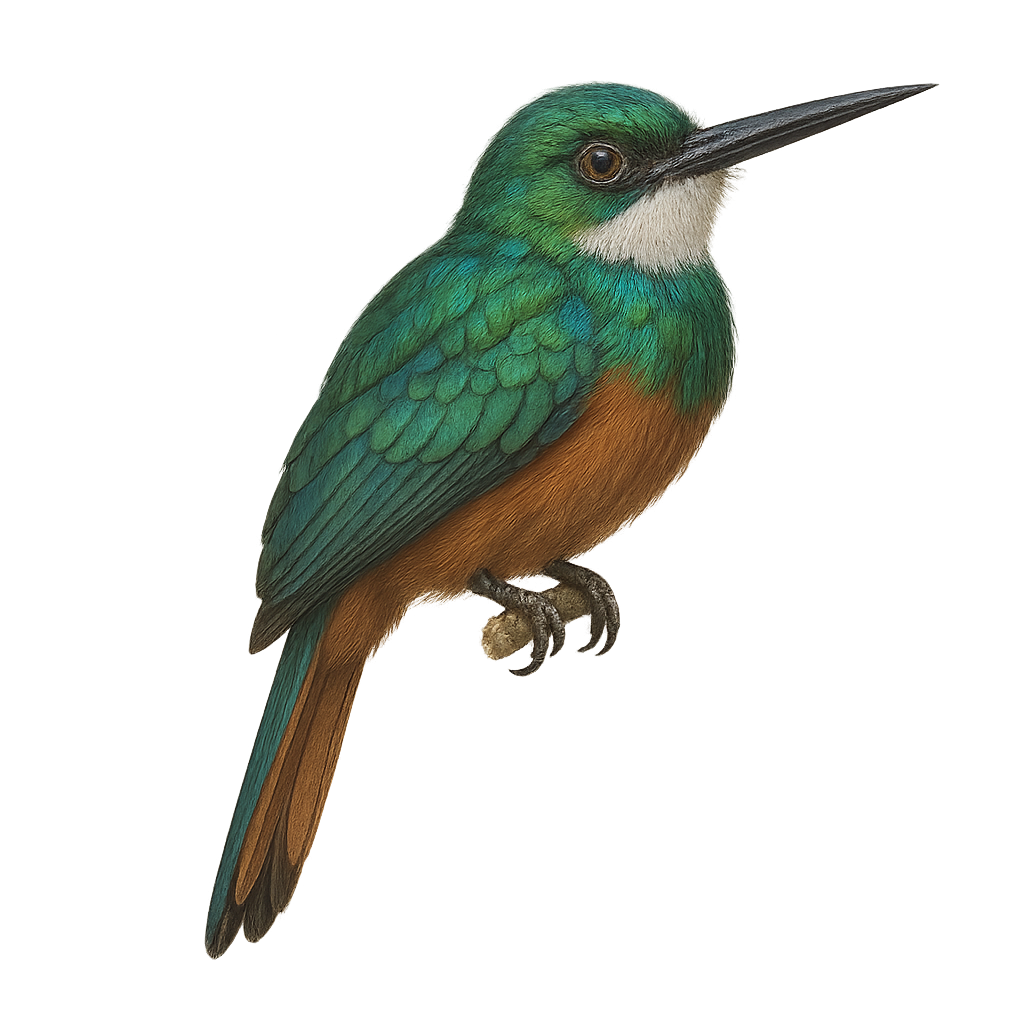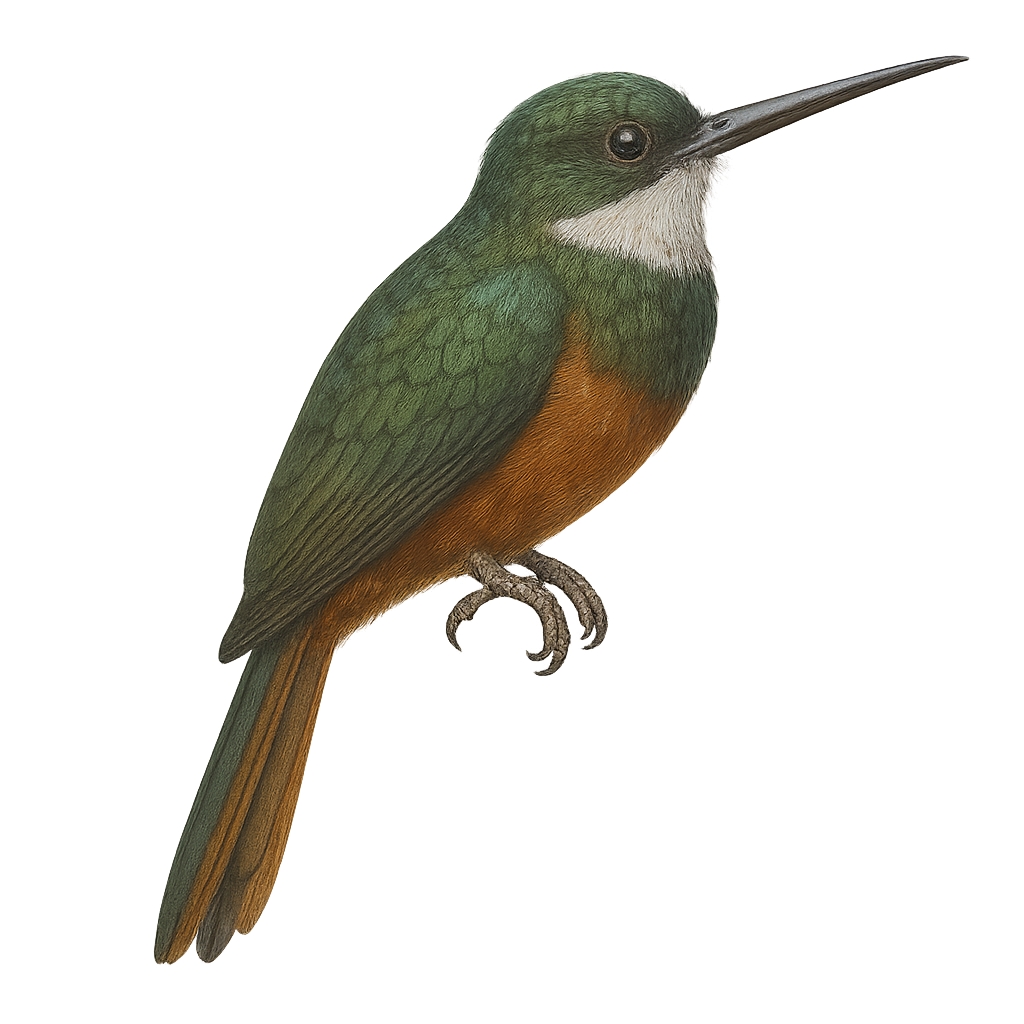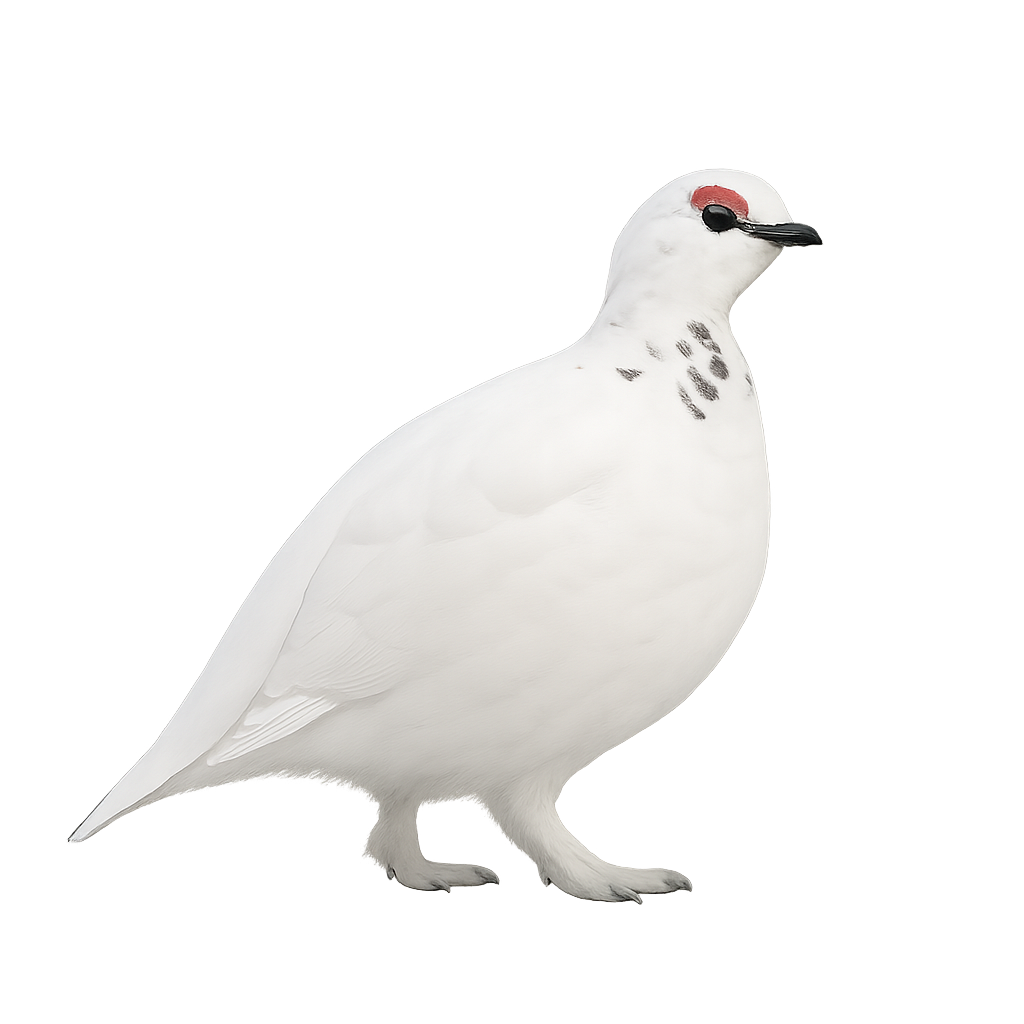The Red-browed Treecreeper, or Climacteris erythrops, is a bird endemic to Australia, primarily found in eucalyptus forests. It is recognized by its reddish-brown plumage and distinctive red eyebrows. Measuring about 17 cm, it is often seen climbing tree trunks in search of insects and spiders. Its song is a melodious trill, often heard at dusk. Although discreet, it is sometimes observed in small family groups. Its ability to blend into its environment makes it difficult to spot, but its curious behavior and distinctive song are valuable clues for attentive observers.
The Red-necked Nightjar is a fascinating nocturnal bird, primarily found in southern Europe and northern Africa. It is distinguished by its mottled brown plumage, which allows it to blend perfectly into its environment. Its rufous throat and long tail are characteristic features. This master of camouflage is often difficult to spot during the day, as it rests motionless on the ground or on low branches. It is most active at dusk and night, feeding mainly on insects caught in flight with its wide beak. Its soft, repetitive song is often heard during summer nights. Although its habitat is threatened by urbanization and intensive agriculture, it remains relatively common in some areas.
The Ridgway's Whip-poor-will is a discreet and mysterious bird, known for its cryptic plumage that allows it to blend seamlessly into its surroundings. Primarily nocturnal, it is often heard rather than seen, emitting melodious calls at dusk. It inhabits dry forests and open wooded areas, feeding mainly on flying insects caught in flight. Its ability to remain motionless for extended periods makes it difficult to spot. Although relatively tolerant of human presence, it prefers quiet, undisturbed habitats. Its breeding season coincides with the abundance of insects, ensuring ample food for its young.
The Ruddy Duck is a small diving duck with distinctive plumage. The male has a black head with a bright blue bill, a reddish-brown body, and often holds its tail upright. The female is more subdued, with brown plumage and subtler facial patterns. These ducks are commonly found in North American wetlands but have also been introduced to Europe. They prefer calm waters rich in vegetation, feeding mainly on aquatic plants, insects, and small crustaceans. Their behavior is generally not very shy, making them accessible for observation. They are known for their spectacular courtship displays, where the male shows off his blue bill and upright tail to attract the female.
The Rupununi Hermit, or Phaethornis rupurumii, is a fascinating hummingbird primarily inhabiting the humid forests and forest edges of South America, particularly in Brazil and Guyana. This small bird, measuring about 12 to 14 cm in length, is distinguished by its olive-brown plumage and long, tapered tail. Its curved beak is perfectly adapted for feeding on the nectar of tubular flowers. The Rupununi Hermit is a solitary bird, often observed darting quickly from flower to flower, playing a crucial role in the pollination of many tropical plants. Although its habitat is relatively stable, deforestation poses a potential threat to its population.
The Reeves's Pheasant, Syrmaticus reevesii, is a striking bird known for its vibrant plumage and exceptionally long tail, which can reach up to 2 meters in males. Native to the mountainous forests of central China, it is often found in diverse habitats ranging from mixed forests to open grasslands. Its plumage is predominantly golden with black and white patterns, making it easily recognizable. Males are particularly noted for their spectacular courtship display, where they fan out their tails and showcase their vivid colors to attract females. Although primarily terrestrial, the Reeves's Pheasant can fly short distances to evade predators.
The red-footed booby is a remarkable seabird, easily recognized by its red feet and its white and brown plumage. It primarily lives on tropical islands in the Pacific and Indian Oceans, where it nests on cliffs or trees near water. It feeds mainly on fish, which it catches by diving from heights. It is a social species living in colonies, but it faces threats due to habitat loss and human disturbances.
The Red Fody, or Foudia madagascariensis, is a small bird endemic to Madagascar, renowned for its striking plumage. Males display a vivid red color on the head and chest, contrasting with brownish wings and back, while females and juveniles are duller, with brownish hues and streaks. This bird measures about 15 cm in length and weighs between 14 and 19 grams. It is often seen in forests, agricultural areas, and even urban gardens. The Red Fody is a sociable bird, living in small groups, and primarily feeds on seeds, insects, and fruits. Its adaptability to various habitats makes it a resilient species, although it is sometimes threatened by the loss of its natural habitat.
The Ring-necked Duck, Aythya collaris, is a medium-sized diving duck known for its distinctive neck ring. Males display a striking black and gray plumage with a blue-gray bill marked by a white band, while females are browner with a white eye ring. They inhabit lakes and ponds across North America, feeding on aquatic plants, seeds, and invertebrates. Their flight is swift and direct, often in small flocks. Although generally wary, they can become accustomed to human presence in protected areas. Their population is stable, but habitat loss remains a potential threat.
The Redhead is a medium-sized diving duck, easily identified by its reddish head, pale blue bill, and gray body. Males have a bright red head, gray back, and white belly, while females are duller with a brownish head and gray-brown body. They inhabit lakes, ponds, and marshes, favoring shallow freshwater. Their diet mainly consists of aquatic plants, seeds, and insects. During breeding season, they often nest in wet meadows or lake islands. Their flight is fast and direct, and they are often seen in large flocks during migration.
The Rufous-chinned Laughingthrush is a medium-sized bird belonging to the Leiothrichidae family. It is primarily found in the mountainous forests of Southeast Asia, particularly in China, Myanmar, and Thailand. This bird is recognizable by its olive-brown plumage with shades of gray and rufous, especially around the throat and cheeks. It usually lives in groups and is known for its varied and melodious vocalizations. The Rufous-chinned Laughingthrush feeds mainly on insects, fruits, and seeds. Although it is relatively common in its natural habitat, deforestation poses a potential threat to its populations.
The Ruffed Grouse, Bonasa umbellus, is a medium-sized forest bird native to North America. It is easily identified by its mottled brown plumage, which provides excellent camouflage in its woodland habitat. Males are famous for their drumming display, a sound created by rapidly beating their wings, which echoes through the woods during the breeding season. This bird prefers mixed forests and dense wooded areas where it feeds on buds, leaves, and insects. Although generally solitary, the Ruffed Grouse can be seen in small groups outside the breeding season. Its ability to remain still and blend into its surroundings makes it a challenging subject for birdwatchers.
The Rufous-vented Ground Cuckoo, Neomorphus geoffroyi, is a rare and intriguing bird found in the tropical forests of Central and South America. It is recognizable by its rufous-brown plumage and distinctive long tail. This terrestrial bird prefers dense undergrowth where it moves stealthily in search of prey such as insects and small vertebrates. Although primarily ground-dwelling, it can fly short distances to escape predators. The Rufous-vented Ground Cuckoo is often heard before it is seen, thanks to its powerful and resonant calls. Its ability to blend into its environment makes it difficult to observe, adding to its mystery and appeal for birdwatchers.
The Rufous-gorgeted Flycatcher, Ficedula hyperythra, is a small passerine bird belonging to the Muscicapidae family. It is mainly found in the montane forests of Southeast Asia, particularly in India, Nepal, Thailand, and China. This bird is distinguished by its characteristic rufous throat, contrasting with its bluish-grey back and white belly. It is often seen alone or in pairs, feeding on insects caught in flight. The Rufous-gorgeted Flycatcher is a migratory bird, moving to lower altitudes during winter. It is appreciated by birdwatchers for its melodious song and its ability to adapt to different forest habitats.
The Ring-billed Gull, Larus delawarensis, is a medium-sized bird easily identified by its yellow bill with a distinctive black ring. Its plumage is primarily white with gray wings and black wingtips. It often frequents coastal areas, lakes, and rivers, but can also be found in urban areas, where it adapts well to human presence. This gull is known for its piercing call and social behavior, often seen in large groups. Opportunistic, it feeds on fish, insects, small mammals, and human waste. Its ability to adapt to various environments makes it a widely distributed species in North America.
The Rufous Antpitta is a secretive bird found in the humid montane forests of South America, primarily in Ecuador and Peru. It is characterized by its reddish-brown plumage and compact size, measuring about 16 cm in length. This bird is more often heard than seen, as it prefers to stay hidden in dense undergrowth. It feeds mainly on insects and other small invertebrates found by foraging on the forest floor. The Rufous Antpitta is a solitary bird, except during the breeding season. It builds its nest on the ground, hidden among fallen leaves. Although its habitat is threatened by deforestation, it is currently classified as Least Concern by the IUCN.
The Rufous-headed Antpitta is a discreet and fascinating bird inhabiting the humid forests of the Andes. This small bird, about 18 cm long, is easily recognizable by its distinct rufous head, contrasting with its olive-brown body. It prefers dense undergrowth where it primarily feeds on insects and other small invertebrates. Although difficult to observe due to its shy behavior and dense habitat, its melodious song is often heard at dawn and dusk. Conservation efforts are crucial for this species as deforestation threatens its natural habitat.
The Ringed Plover is a small coastal bird primarily found along beaches, estuaries, and sandy areas in Europe, North Africa, and Asia. It measures about 18 to 20 cm in length, with a wingspan of 40 to 45 cm, and weighs between 30 and 60 g. Its plumage is generally light beige with white underparts and an interrupted black ring around the neck and chest. This collar is more pronounced in males, while females have a less distinct collar. The Ringed Plover primarily feeds on small marine invertebrates and insects found in the sand or along the shore. It is often seen running along the waves, searching for food. While its population remains relatively stable, this species can be threatened by habitat loss, pollution, and human disturbances at its breeding sites.
The red-necked grebe is a water bird found primarily in lakes, ponds, and wetlands across Europe and Asia. It is easily recognized by its contrasting plumage, with a reddish-orange head and neck during the breeding season and more subdued plumage outside of it. This grebe primarily feeds on fish, aquatic invertebrates, and aquatic plants, which it captures by diving underwater. It is also known for its spectacular courtship displays.
The Redwing, or Turdus iliacus, is a small migratory bird belonging to the Turdidae family. It is characterized by its reddish-brown plumage on the back and reddish flanks, contrasting with its white belly. Its melodious song is often heard in the forests and parks of Europe and Asia, where it feeds mainly on berries and insects. In winter, it migrates south, sometimes reaching North Africa. The Redwing is a sociable bird, often seen in flocks, especially during migration. It typically nests in trees or shrubs, building a cup-shaped nest with twigs and mud.
The Red-bearded Bee-eater, or Nyctyornis amictus, is a striking bird native to the tropical forests of Southeast Asia. Easily identifiable by its vivid red throat and bright green plumage, it measures about 25 to 30 cm in length. This bird is known for its sturdy, slightly curved beak, perfect for catching flying insects, especially bees and wasps. It prefers dense wooded habitats, where it can perch discreetly while waiting for prey. The Red-bearded Bee-eater is a solitary bird, often seen alone or in pairs. Its breeding season varies by region, but it typically nests in tree cavities or sandy banks. Although its conservation status is currently "Least Concern," deforestation poses a potential threat to its natural habitat.
The Rufous-crowned Bee-eater, or Merops americanus, is a colorful and fascinating bird known for its vibrant plumage and social behavior. It features bright feathers in shades of green, blue, and yellow, with a long, curved beak ideal for catching insects in flight. This bird is often seen in groups, nesting in colonies on sandy banks. It primarily feeds on bees and wasps, which it skillfully captures. The Rufous-crowned Bee-eater is a migratory bird, traveling long distances between its breeding grounds and wintering areas. It is appreciated for its beauty and its role in controlling insect populations.
The Rainbow Bee-eater, Merops ornatus, is a colorful and fascinating bird primarily found in Australia and New Guinea. Its slender silhouette and vibrant colors, ranging from emerald green to azure blue, make it a remarkable visual spectacle. This bird measures about 23 to 28 cm in length, with a long, tapered tail. It is known for its aerial prowess, catching insects in flight, particularly bees and wasps. The Rainbow Bee-eater is often seen in groups, nesting in burrows dug into sandy banks. Its melodious song and aerial courtship displays add to its charm. Although widely distributed, it is sensitive to disturbances in its natural habitat.
The Rosy Bee-eater, Merops malimbicus, is a graceful member of the Meropidae family, found across Central and Western Africa. It inhabits tropical forests, open savannas, clearings, and riverbanks, often seen soaring above the canopy or perched in the open. This species is easily recognized by its long triangular wings, uniform grey upperparts, rosy-pink underparts, a black eye stripe, and a sharp white moustache. Partially migratory, it sometimes forms massive breeding colonies with over 20,000 pairs. It nests in tunnels dug into sandy riverbanks or sandbars. Its call consists of harsh, brief notes like tik and trrp, typical of bee-eaters.
The Red-legged Honeycreeper, Cyanerpes cyaneus, is a small, vibrantly colored tropical bird, primarily electric blue with black wings and red legs. It is commonly found in the humid forests and wooded areas of Central and South America. This nectarivore feeds mainly on nectar but also consumes fruits and insects. Males display a striking plumage, while females are generally olive green with bluish hues. The Red-legged Honeycreeper is a social bird, often seen in small groups, and is known for its aerial acrobatics when feeding. Its breeding season varies by region but is generally active year-round in tropical areas.
The Red-throated Ant-tanager is a medium-sized bird, primarily recognized for its bright red throat in males, while females display more subdued tones. It is mainly found in the tropical and subtropical forests of Central America, favoring dense undergrowth. This bird is often seen in small groups, feeding on insects and fruits. Its song is a soft whistle, often heard at dawn. Although relatively common in its natural habitat, it remains discreet and difficult to spot due to its plumage that blends into the forest environment. Its ability to adapt to various forest habitats makes it a resilient species in the face of deforestation.
The Red-breasted Merganser is a slender diving duck, measuring about 52 to 58 cm in length with a wingspan of 67 to 82 cm. The male features a dark green head with a shaggy crest, a white collar, a rusty speckled chest, and a thin red bill. The female has a reddish-brown head with a more subdued crest, a grayish body, and a duller red bill. This duck inhabits coastal waters, estuaries, bays, and large lakes, favoring saline or brackish areas. It primarily feeds on small fish, but also consumes crustaceans, aquatic insects, and amphibians, captured using its serrated bill adapted for fishing. A migratory species, it nests on the ground near water, often concealed under vegetation or in rocky crevices. Although listed as Least Concern by the IUCN, the Red-breasted Merganser is sensitive to water pollution, coastal habitat destruction, and human disturbances.
The Rufous-tailed Jacamar, or Galbula tombacea, is an elegant and colorful bird primarily found in the tropical forests of South America. It is recognizable by its metallic green plumage on the back and head, contrasting with its white throat and distinctive rufous tail. This bird measures about 25 cm in length and has a long, slender beak, perfect for catching insects in flight. It is often seen perched quietly on a branch, scanning its surroundings for prey. The Rufous-tailed Jacamar is a diurnal bird, active mainly during the day. It prefers dense forest habitats but can also be found in open wooded areas and forest edges.
The Rufous-tailed Jacamar is an elegant and colorful bird, easily recognizable by its metallic green plumage and long rufous tail. It primarily inhabits the dense tropical forests of Central and South America, where it feeds mainly on insects caught in flight with its long, slender bill. This bird measures about 25 cm in length and is often seen perched quietly on low branches, from where it surveys its territory. Although discreet, its melodious song can be heard throughout the canopy. The Rufous-tailed Jacamar is a sociable bird, often seen in small groups or pairs, and it plays an important role in controlling insect populations in its natural habitat.
The Rock Ptarmigan is a mountain bird adapted to the harsh conditions of high peaks. It measures about 35 to 40 cm in length and weighs between 350 and 650 g. In winter, its plumage is entirely white, allowing it to blend into the snow, while in summer, it has a brown-red plumage with dark spots to better blend into the rocks and grasses of the mountains. The Rock Ptarmigan primarily inhabits mountainous regions of Europe, Asia, and North America at high altitudes, where it feeds on plants, seeds, berries, and young shoots. Due to its thick plumage and feather-covered legs, it is well adapted to cold conditions but is also vulnerable to climate change, particularly to the loss of its mountainous habitat. The species is protected in some areas but remains sensitive to human disturbances, such as mountain tourism and temperature changes.


